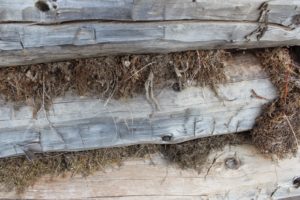 The log home industry has come a long way in developing a product to prevent unwanted water and other invasions in log homes. Before we started using the synthetic mortar of today’s energy seal products, there were a variety of ways in which a log home owner would try to close gaps in between logs and keep water, bugs, and air drafts from entering their home.
The log home industry has come a long way in developing a product to prevent unwanted water and other invasions in log homes. Before we started using the synthetic mortar of today’s energy seal products, there were a variety of ways in which a log home owner would try to close gaps in between logs and keep water, bugs, and air drafts from entering their home.
In early history, chinking or the “process of chinking” was the installation of various materials installed in horizontal voids between log courses on log walls to prevent air and water from entering the home. Over the years the process has come to mean the product used, not the process per say.
All of these compounds were considered a very temporary solution. They all lacked in adhesion to the wood as well as flexibility. When the logs moved, expanded or contracted, the products used to seal could not adjust with the log movement, and other gaps were then exposed. Every year before winter hit, everyone was out “chinking” the home in preparation.
When mortar was used on some specific joint designs, they developed stress cracks and the nails used to help hold the mix during the installation rusted and allowed the cement to pull away and sometimes fall out. The cement in the horse or animal hair mixtures was so alkaline that it eventually dissolved the protein in the hair and left voids in the mortar, allowing water and air back in.

(Top image provided by findingmyalaska.blogspot.com)








